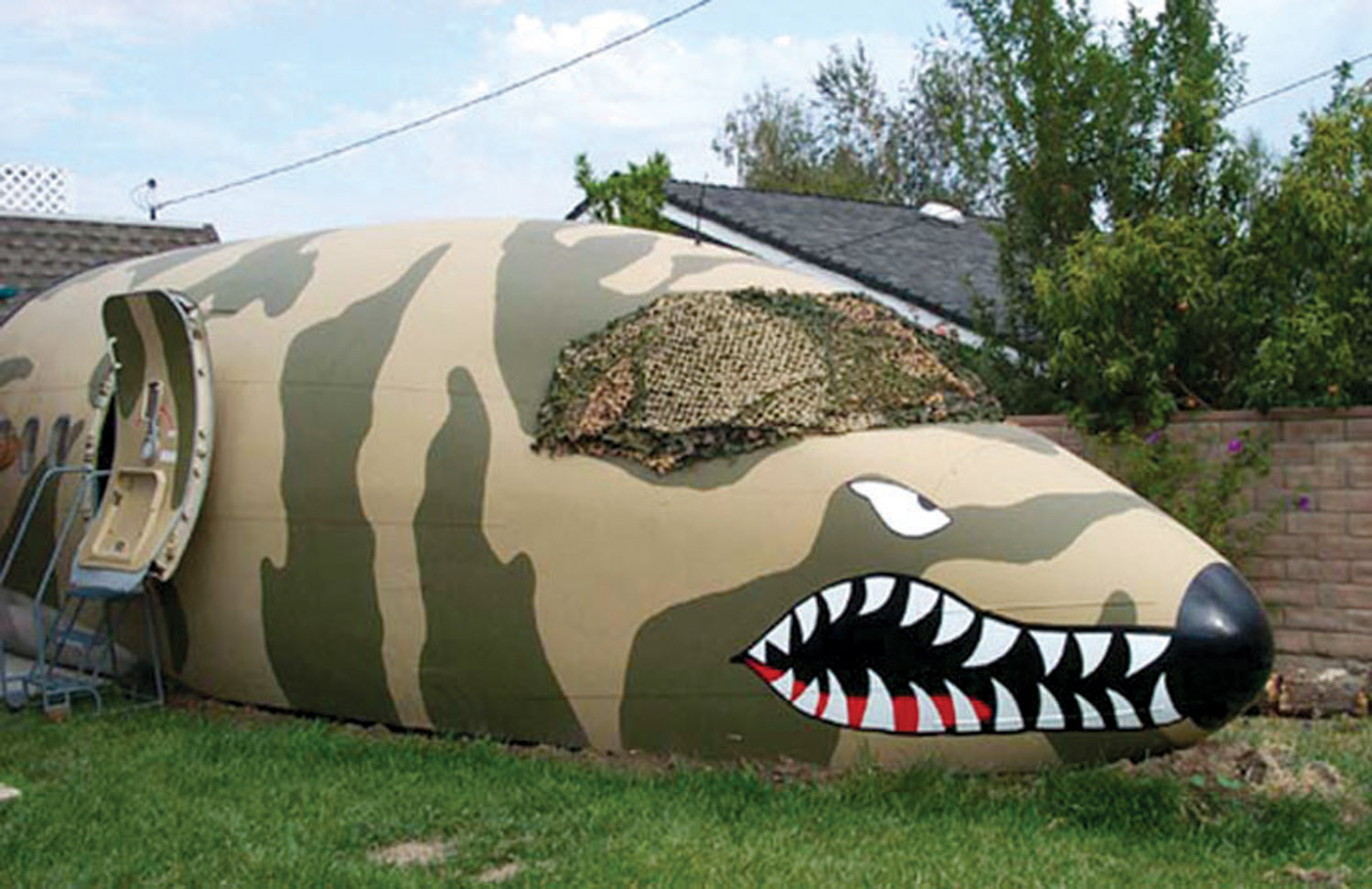By Shirley Lee
When officials of the Discovery Channel’s “Monster House” television show approached Mark and Debbie Penikas with the idea of remodeling their Simi Valley, Calif. home into an “Aviation House,” the couple wasn’t certain of all it entailed. Still, they decided to take a chance and live adventurously. Little did they dream that within a short time they would find themselves giving space to the front 35 feet of a real Boeing 727 airliner in their back yard.

The front 35 feet of a retired Boeing 727 airliner, which resides in the Penikas family’s backyard, courtesy of the “Monster House,” makes a one-of-a-kind hideaway recreation room.
According to Ali McCallister, the show’s producer, that was “the greatest thing the show has done so far,” in the four years they’ve spent creating unusual theme houses from average homes.
“We don’t live by the rules,” host Steve Watson admits proudly. “We do things that others can’t.”
To date, that has included a “Race Car House” and a “Magic House,” among many others. Although the 727 fuselage was donated for this “Monster House” episode, the remainder of this project cost the show in excess of $20,000.
The Penikas family of four was chosen for the “Monster Aviation House” (Show 52, airing on September 9 at 8 p.m. PST) because of their longstanding involvement within the field of aviation. Although Mark Penikas grew up around aircraft, he started his professional career some years ago in the U.S. Air Force and was assigned to a Pentagon-directed Special Operations Unit. After his honorable discharge, he continued on with law enforcement at the federal and state levels, and years later, retired as a California state law enforcement officer.
Retiring at a young age, he went into his new career heading up international corporate security for such Fortune 500 companies as JBL/Harman International and Intel Corporation. During his “second” career, he also continued on with his education and received his doctorate in 2003. Dr. Penikas now consults in the aviation and aeronautics industry, developing unmanned aerial vehicle designs, along with a partner who is currently an airline captain and former U.S. Navy fighter pilot.
Penikas also designs and develops radio controlled scale aircraft. As an aviation consultant, he’s done numerous RC aircraft reviews for magazines and spends a great deal of time testing and analyzing, and improving new designs and related products. He’s built aircraft for the movies, as well as for private party and corporate clients wanting a “scaled down, fully airworthy” re-creation of their full-size aircraft. Penikas regularly competes in various RC competitions, aviation fairs and air shows. He’s also president of Simi Valley Flyers, a radio control model airplane club, and equally active with the Channel Islands Condors.
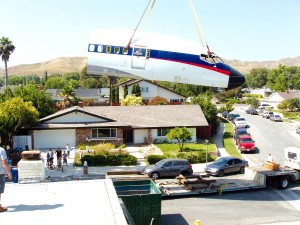
A giant crane lifts the 10,000-pound, 35-foot-long portion of a 727 fuselage high above the Penikas’ house, and lowers it into their back yard.
His association with airplanes and aviation dates back to his early childhood years. His father, Robert “Bob” Penikas, flew with Flying Tigers and Federal Express, was a Boeing 747 instructor, and is, today, a talented aviation artist. His mother, Patti Penikas, recently retired as a captain for US Airways. One of the first female airline pilots, she also flew for Western and Piedmont Airlines during her aviation career.
On the other side of the family, Debbie Penikas’ grandfather, Anthony C. Luz, was reportedly the first pilot to fly over Pike’s Peak in Colorado in an open-cockpit biplane.
“It was a rescue mission back in 1927,” Mark Penikas said. “There were some people stranded in the snow up there and there was no other way to get help to them.”
Debbie Penikas added, “My grandfather flew up over the mountain and dropped supplies down to them.”
Their two sons, Tommy, 14, and Justin, 13, fly radio-controlled aircraft that the family constructs, and on occasion serve as youthful instructors to large groups of their peers.
The makeover
Since the end result of the “remodeling” of their tri-level, six-bedroom house was to be a complete surprise for the family, they weren’t allowed to watch the “Monster House” team at work.
“We spent about a week living in a small RV trailer they parked right in front of the house,” Mark Penikas said. “Although we weren’t allowed to go in and see what they were doing, they did their best to intrigue us by letting us see some of the things they carried inside. Sometimes they deliberately brought in things they weren’t really going to use to trick us. They took pictures of us and our reactions at odd moments.”

L to R: Tommy and Justin Penikas agree that working with the flight simulator system in the cockpit of their own 727 aircraft is a “cool” thing to do.
Two rooms received special treatment; about 100 airplane parts were incorporated into the décor. Now, adjoining the kitchen, on a lower level, is a comfortable “pilot’s lounge” where the family can relax and watch television on a projection screen lowered out of an airplane wing fastened across the ceiling. The seating section consists of four leather lounge recliners spaced in two rows, with the back row on a raised platform. Beneath the TV screen, where there was once a typical stone fireplace with a wide mantel, is a custom-made aluminum fireplace fashioned from an airplane engine.
“We’ve even got the airline blankets and pillows,” remarks Mark.
At one side of the room, the remodeled wet bar features seats made of a plane’s landing gear, which rise or fold down with electronic assistance, simulating retractable landing gear on an airplane. Walls mural-painted to resemble a colorful, cloudy sky, populated with appropriate aircraft zooming here and there, enhance the entire area. A few of the family’s own collection of some 300 RC aircraft are artfully displayed on the ceiling, attached in a way that allows them to be taken down and flown. One painting Bob Penikas created just for the room, of an F4U Corsair “Blue Max,” graces an adjacent wall.
Mark Penikas’ home office also received a makeover. Ribs from the fuselage of an aircraft were turned into an attractive bookcase. When he works, he sits behind a one-of-a-kind piece of furniture.
“They built this desk from an old elevator of an airplane and put a big piece of glass on it,” he said. “The bookshelf in the corner is the leading edge of a wing.”
The realm of the 727
A private door out to the back yard leads to the piece de resistance. With all the surprises in store for them, the biggest, of course, was the 35-foot-long front half fuselage section of a commercial 727 airplane now located directly behind the office side of the house. Fortunately, their backyard is large enough to accommodate a covered patio and their large motor home as well.
A 165-ton crane was needed to lift the 10,000-pound plane section from the flatbed truck carrying it, transport it across the yard and over the roof of the house, and lower it on the far side of the wall-enclosed corner lot. Without knowing why, the family had agreed to the request not to pay a visit to their home on the day the plane was scheduled to arrive. Nevertheless, Mark Penikas needed to be in the neighborhood long enough to pick his younger son up from the nearby elementary school. The timing turned out to be all wrong.
“The delivery happened during the peak hour when the school was letting out,” says Debbie Penikas. “The street was literally closed down and people were lining the street and sitting in lawn chairs to see what was happening, The crane hit some of the street lights so they had to be temporarily removed.”
Mark Penikas could tell that something big was going on, but had no idea what it was, since they’d been asked to stay away.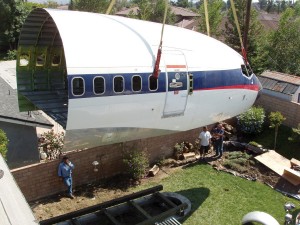
“I could see the crane standing about 200 feet taller than the 70-some-foot tree that was right next to it,” he recalled. “There were two news helicopters flying around. It turned out that although the producers of the show had all the necessary permits to deliver the plane, the city had forgotten to tell the mayor, the police and the fire department. Word had gotten out that an airliner had crashed into the street out there, and the police were trying to get in to respond and couldn’t. In all the commotion, one of the onlookers passed out and they could see someone being loaded into an ambulance and airplane pieces lying about. Then, the police car had a hard time entering the area due to the large number of people.”
Debbie Penikas, who works in Thousand Oaks, knew something was going on when her husband called her and said, “There’s a huge crowd of people lining up in front of our house.”
“And I’m supposed to conduct myself as usual at my job?” she remembered thinking.
“I was informed that the mayor showed up there as well,” Mark Penikas said. “I got a call the next morning from the county, asking if everything was all right at our house. They obviously must’ve known what happened, but they wouldn’t give me any details.”
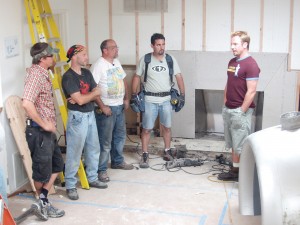
On day one of the “Aviation House” project, Steve Watson discusses ways to turn an ordinary room into a pilots’ lounge with builders L to R: Matthew Potter, Steve Rapak, Les Delinski and Dan Golden.
So the viewing of their Aviation House remained a complete—and happy—surprise right up until the end, when Steve Watson walked them through it. The day was one of complete celebration with McAllister and Brian Knappmiller, the show’s director, joining in the fun.
The air-conditioned plane makes an appealing recreation room. Furniture includes an army cot and a sofa bed in what must once have been the first-class passenger section. Window blinds, when closed, keep it cool and private. The Boeing 727 cockpit area is complete with a flight simulator system.
“I especially like being in there as there is no phone line and it’s very peaceful,” reveals Mark Penikas. Musing, he adds, “Some day I may put all of my aviation books and research material in there and make it into a library.”
There’s another aspect regarding his backyard aircraft that he finds personally rewarding.
“This 727 was donated for the project by Dodson Aircraft International,” he says, smiling. “It was shipped all the way from Kansas, and was a former Delta Airliner. There’s a good possibility that both my mom and business partner may have flown this very plane at one time or another.”
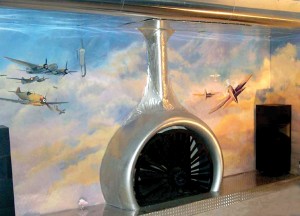
The custom-made aluminum fireplace in the “pilot’s lounge” is fashioned from a real airplane engine. A projection screen can be lowered from the airplane wing fastened across the ceiling. The colorful wall mural adds to the aviation theme, while pilots’ l











